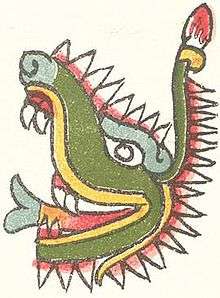cipactli
Classical Nahuatl
FWOTD – 7 January 2015

The glyph for the day sign "alligator" in the Codex Magliabechiano.
Etymology
This etymology is incomplete. You can help Wiktionary by elaborating on the origins of this term.
Pronunciation
- IPA(key): [siˈpak.t͡ɬi]
Noun
cipactli (animate and inanimate)
- (it is) an unspecified, mythological reptilian animal; akin to an alligator or caiman.
- (it is) the first of the twenty day signs of the tōnalpōhualli; the disembodied head of this mythical animal.
- 16th c.: Codex Magliabechiano, f. 11r.
- nau ci pac tl. qúe / es. Vna cosa biba / q anda en agu / como. ser pezilla.
- nau cipactl. [sic] which is a living, aquatic snakelike creature”.
- nau ci pac tl. qúe / es. Vna cosa biba / q anda en agu / como. ser pezilla.
- 16th c.: Codex Magliabechiano, f. 11r.
Usage notes
- Authors differ on the precise translation of cipactli; and thus it is variously translated as “alligator,” “caiman,” “serpent,” and even “shark,” as is the case in Siméon. Séjourné asserts that the term probably does not correspond to any real animal, but adopts the translation “alligator”.
Synonyms
- (alligator): ācuetzpalin
References
- Rémi Siméon (1885) Diccionario de la lengua náhuatl o mexicana, Siglo Veintiuno Editores, page 111
- Laurette Séjourné (1981) El pensamiento náhuatl cifrado por los calendarios, Siglo Veintiuno Editores, pages 16, 211
This article is issued from
Wiktionary.
The text is licensed under Creative
Commons - Attribution - Sharealike.
Additional terms may apply for the media files.